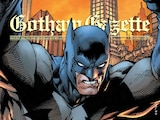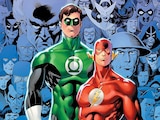I was about a third of the way through reading Harleen #1, the first chapter of Stjepan Sejic’s gorgeous new DC Black Label series, when an interesting thought occurred to me—for as well as I feel like I know Harley Quinn, I really don’t know Dr. Harleen Quinzel at all.
Any DC fan can tell you that Harley Quinn, the anarchic troublemaker with an eye for Clown Princes and a penchant for wearing red and black, began as an Arkham Asylum psychiatrist who fell in love with the Joker. But ask them what she was like prior to that pivotal moment and the picture gets much murkier. Attempts to fill in Harleen’s backstory have tended to be darkly comical, painting her as a villain from birth who somehow managed to gain a PhD in psychiatry and a highly sought-after position at Arkham working with one of the world’s most notorious psychopaths. They’ve also often broken the fourth wall, making it unclear how seriously we’re meant to take them.

I say all this because I know for many DC fans, the big question when it comes to new Harley Quinn comics is simply: “Why?” There are at least five current Harley comics and graphic novels in stores or about to hit the stands, including her ongoing monthly series and a second Black Label series arriving on the heels of this one (Kami Garcia, Mico Suayan and Mike Mahew’s Joker/Harley: Criminal Sanity, which is out on 10/9). And I’m not even counting books like DC Super Hero Girls and the now collected Heroes in Crisis, in which she plays a role. In other words, you already have a lot of options for getting your Harley fix. Why do we need this latest one, especially since for many readers, a little Harley goes a long way?
The answer is right there in the title. There’s a reason that Sejic chose to call this comic Harleen—it’s Harleen Quinzel’s story. Sure, it’s pretty clear that at one point we’ll see Dr. Quinzel evolve into the villain that she’s destined to become. But even so, it’s Harleen, not Harley, that we’re getting to know, and it turns out that she’s a remarkably appealing character.

After a brief dream sequence and exchange with a patient, Harleen begins with a 30-year-old Dr. Quinzel giving a presentation to gain funding for an experimental study and realizing halfway through it that she’s lost the audience. She’s not going to be successful. Sejic, who makes generous use of internal narrative throughout this first chapter, chooses not to use it here, instead making her failure clear to us via a quick image of an audience member checking his watch and a few telling stammers in Harleen’s speech. It’s a subtle beginning built around a character who is almost never subtle, and it makes it immediately clear that we’re in for a different sort of Harley story.
This is further supported by the issue’s second major sequence, in which Harleen meets the Joker for the first time. Finding herself in the wrong place at the wrong time, the doctor witnesses a robbery by the Joker and his crew and is held at gunpoint in such fear for her life that much of it flashes before her eyes. It’s such a traumatic event that for the rest of the issue, Harleen’s haunted by horrifying nightmares of the incident that at times keep her from sleeping at all.
Taken together, the two scenes set up an instant mystery: How will this unsuccessful and terrified young doctor eventually find herself falling in love with the man responsible for causing her such fear?

Watching the events unfold that ultimately set her on that path is much of the joy of this first chapter, yet while this may help us relate to and appreciate Harleen Quinzel in a way that we haven’t before, it also makes it painfully clear that this story will likely be a tragic one. By the end of the first chapter, we’ve seen Harleen overcome her past and her admitted flaws and is well on her way to achieving the ambitious and altruistic goal she’s set out to achieve. For her to become Harley would represent a loss of that potential—another failure of Harleen’s, only this time a shockingly damaging one.
Or maybe not. All of this could change depending on what Sejic chooses to do with the Joker in the book’s two remaining chapters. While, as other writers have pointed out, Sejic has reimagined Batman’s main adversary as a younger, far more attractive villain than we’re accustomed to seeing, we don’t know much more about this version of him other than that. The image we do piece together by issue’s end is conveyed entirely through his reputation and small moments of out-of-nowhere brutality. It suggests that everything we know about the Joker from other comics is also true of the Joker we meet in Harleen, but it leaves room for doubt. So, when he does things like sparing Harleen’s life—not yet knowing she was a doctor at Arkham—it’s easy to wonder if there might not be more to this Joker than is clear on the surface.

Of course, this line of thinking will almost certainly be Harleen’s undoing, so the fact that we’d even entertain it just shows how dangerous of a manipulator that green-haired psycho really is. But there’s more at play here than just that. Having read Harleen #1, we want Harleen Quinzel to succeed and to prove naysayers like Harvey Dent and her former classmates wrong. That means that if she’s not destined to become the cutting-edge criminal psychiatrist that she sets out to be and will instead fall in love with the Joker and allow his influence to cause her to become Harley Quinn, then dammit, we want that to be the ultimate win for her. We want becoming Harley Quinn to be more important, more fulfilling, more cathartic and more empowering than her work as a psychiatrist ever could have been. Harleen seems destined to be a tragic tale, but like all the best tragedies, we hope that our expectations are wrong. We still long for Harleen’s happy ending.
Harley Quinn’s growth and evolution has become an important one to millions of fans worldwide. Stjepan Sejic’s new series tells us that Harleen Quinzel’s matters just as much.
Harleen #1 by Stjepan Sejic is now available in print and as a digital download.
Tim Beedle covers movies, TV and comics for DCComics.com and writes our monthly Superman column, "Super Here For...". Look for him on Twitter at @Tim_Beedle.















